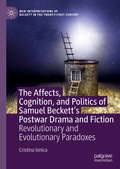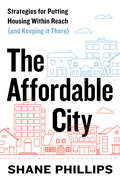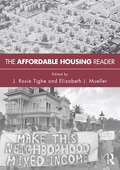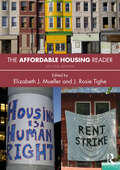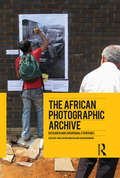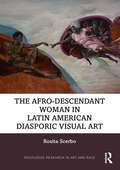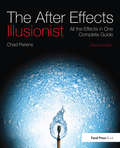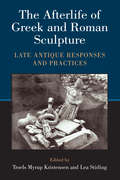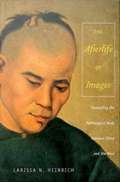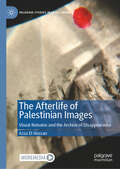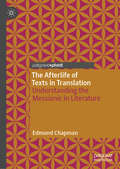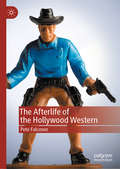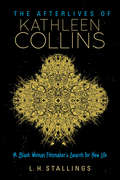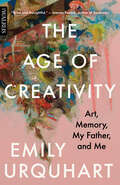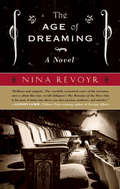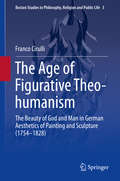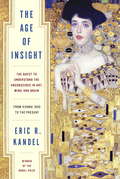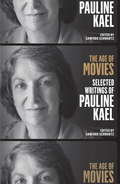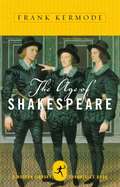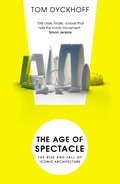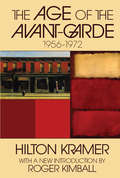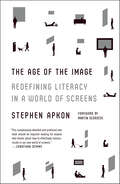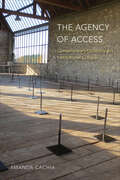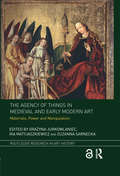- Table View
- List View
The Affects, Cognition, and Politics of Samuel Beckett's Postwar Drama and Fiction: Revolutionary and Evolutionary Paradoxes (New Interpretations of Beckett in the Twenty-First Century)
by Cristina IonicaThe Affects, Cognition, and Politics of Samuel Beckett’s Postwar Drama and Fiction: Revolutionary and Evolutionary Paradoxes theorizes the revolutionary and evolutionary import of Beckett’s works in a global context defined by increasingly ubiquitous and insidious mechanisms of capture, exploitation, and repression, alongside unprecedented demands for high-volume information-processing and connectivity. Part I shows that, in generating consistent flows of solidarity-based angry laughter, Beckett’s works sabotage coercive couplings of the subject to social machines by translating subordination and repression into processes rather than data of experience. Through an examination of Beckett’s attack on gender/ class-related normative injunctions, the book shows that Beckett’s works can generate solidarity and action-oriented affects in readers/ spectators regardless of their training in textual analysis. Part II proposes that Beckett’s works can weaken the cognitive dominance of constrictive “frames” in readers/ audiences, so that toxic ideological formations such as the association of safety and comfort with simplicity and “sameness” are rejected and more complex cognitive operations are welcomed instead—a process that bolsters the mind’s ability to operate at ease with increasingly complex, malleable, extensible, and inclusive frames, as well as with increasing volumes of information.
The Affordable City: Strategies for Putting Housing Within Reach (and Keeping it There)
by Shane PhillipsFrom Los Angeles to Boston and Chicago to Miami, US cities are struggling to address the twin crises of high housing costs and household instability. Debates over the appropriate course of action have been defined by two poles: building more housing or enacting stronger tenant protections. These options are often treated as mutually exclusive, with support for one implying opposition to the other.Shane Phillips believes that effectively tackling the housing crisis requires that cities support both tenant protections and housing abundance. He offers readers more than 50 policy recommendations, beginning with a set of principles and general recommendations that should apply to all housing policy. The remaining recommendations are organized by what he calls the Three S's of Supply, Stability, and Subsidy. Phillips makes a moral and economic case for why each is essential and recommendations for making them work together.There is no single solution to the housing crisis—it will require a comprehensive approach backed by strong, diverse coalitions. The Affordable City is an essential tool for professionals and advocates working to improve affordability and increase community resilience through local action.
The Affordable Housing Reader
by J. Rosie Tighe Elizabeth J. MuellerThe Affordable Housing Reader brings together classic works and contemporary writing on the themes and debates that have animated the field of affordable housing policy as well as the challenges in achieving the goals of policy on the ground. The Reader – aimed at professors, students, and researchers – provides an overview of the literature on housing policy and planning that is both comprehensive and interdisciplinary. It is particularly suited for graduate and undergraduate courses on housing policy offered to students of public policy and city planning. The Reader is structured around the key debates in affordable housing, ranging from the conflicting motivations for housing policy, through analysis of the causes of and solutions to housing problems, to concerns about gentrification and housing and race. Each debate is contextualized in an introductory essay by the editors, and illustrated with a range of texts and articles. Elizabeth Mueller and Rosie Tighe have brought together for the first time into a single volume the best and most influential writings on housing and its importance for planners and policy-makers.
The Affordable Housing Reader
by J. Rosie Tighe Elizabeth J. MuellerThis second edition of The Affordable Housing Reader provides context for current discussions surrounding housing policy, emphasizing the values and assumptions underlying debates over strategies for ameliorating housing problems experienced by low-income residents and communities of color. The authors highlighted in this updated volume address themes central to housing as an area of social policy and to understanding its particular meaning in the United States. These include the long history of racial exclusion and the role that public policy has played in racializing access to decent housing and well-serviced neighborhoods; the tension between the economic and social goals of housing policy; and the role that housing plays in various aspects of the lives of low- and moderate-income residents. Scholarship and the COVID-19 pandemic are raising awareness of the link between access to adequate housing and other rights and opportunities. This timely reader focuses attention on the results of past efforts and on the urgency of reframing the conversation. It is both an exciting time to teach students about the evolution of United States’ housing policy and a challenging time to discuss what policymakers or practitioners can do to effect positive change. This reader is aimed at students, professors, researchers, and professionals of housing policy, public policy, and city planning.
The African Photographic Archive: Research and Curatorial Strategies
by Christopher MortonAfrican photography has emerged as a significant focus of research and scholarship over the last twenty years, the result of a growing interest in postcolonial societies and cultures and a turn towards visual evidence across the humanities and social sciences. At the same time, many rich and fascinating photographic collections have come to light. This volume explores the complex theoretical and practical issues involved in the study of African photographic archives, based on case studies drawn from across the continent dating from the 19th century to the present day. Chapters consider what constitutes an archive, from the familiar mission and state archives to more local, vernacular and personal accumulations of photographs; the importance of a critical and reflexive engagement with photographic collections; and the question of where and what is ‘Africa’, as constructed in the photographic archive. Essential reading for all researchers working with photographic archives, this book consolidates current thinking on the topic and sets the agenda for future research in this field.
The Afro-Descendant Woman in Latin American Diasporic Visual Art (Routledge Research in Art and Race)
by Rosita ScerboBy studying multiple cultural expressions of Blackness throughout different regions of the Americas, the chapters of this book consider the relationship that social and historical processes such as sovereignty and colonialism have on cultural productions made by and about Black Latin American women.Rosita Scerbo analyzes a range of power dynamics as represented in different artistic media of the Afro-Latin/x American community, including photography, muralism, performance, paintings, and digital art. The book acknowledges that racial and gender equity cannot exist without Intersectionality and that is why the entirety of the chapters focus on cultural and visual productions exclusively created by Afro-descendant women. The Black Latin American women featured in the various chapters, spanning multiple artistic mediums and originating from various Latin American and Caribbean nations, including Mexico, Colombia, the Dominican Republic, Puerto Rico, Brazil, and Cuba, collectively pursue the central aim of foregrounding the Afro-descendant woman’s experience. Simultaneously, they strive to enhance the visibility and acknowledgment of gendered Afro-diasporic culture within the Latin American context.The book will be of interest to scholars working in art history, gender studies, women’s studies, Latin American studies, African diaspora studies, and race and ethnic studies.
The After Effects Illusionist: All the Effects in One Complete Guide (All The Effects In One Complete Guide Ser.)
by Chad PerkinsFirst published in 2012. Routledge is an imprint of Taylor & Francis, an informa company.
The Afterlife of Greek and Roman Sculpture: Late Antique Responses and Practices
by Lea Stirling Troels Myrup Kristensen"This book developed out of two seminars held in the Department of History and Classical Studies at Aarhus University on 26 September 2008 and 25 March 2011."
The Afterlife of Images: Translating the Pathological Body Between China and the West
by Larissa N. HeinrichIn 1739 China's emperor authorized the publication of a medical text that included images of children with smallpox to aid in the diagnosis and treatment of the disease. Those images made their way to Europe, where they were interpreted as indicative of the ill health and medical backwardness of the Chinese. In the mid-nineteenth century, the celebrated Cantonese painter Lam Qua collaborated with the American medical missionary Peter Parker in the creation of portraits of Chinese patients with disfiguring pathologies, rendered both before and after surgery. Europeans saw those portraits as evidence of Western medical prowess. Within China, the visual idiom that the paintings established influenced the development of medical photography. In The Afterlife of Images, Ari Larissa Heinrich investigates the creation and circulation of Western medical discourses that linked ideas about disease to Chinese identity beginning in the eighteenth century. Combining literary studies, the history of science, and visual culture studies, Heinrich analyzes the rhetoric and iconography through which medical missionaries transmitted to the West an image of China as "sick" or "diseased. " He also examines the absorption of that image back into China through missionary activity, through the earliest translations of Western medical texts into Chinese, and even through the literature of Chinese nationalism. Heinrich argues that over time "scientific" Western representations of the Chinese body and culture accumulated a host of secondary meanings, taking on an afterlife with lasting consequences for conceptions of Chinese identity in China and beyond its borders.
The Afterlife of Palestinian Images: Visual Remains and the Archive of Disappearance (Palgrave Studies in Arab Cinema)
by Azza El HassanThe Afterlife of Palestinian Images is a groundbreaking study of how colonial violence alters and changes visual objects - which in turn affects how a society and culture relates to its own images. Based on the practice-based creative methodology of Palestinian filmmaker and researcher Azza El Hassan, this book explores the re-use and re-appropriation of photos, film and media equipment that have survived looting and destruction, objects which become a constant reminder of what was and what has been lost. El Hassan goes beyond using these visual remains as simple evidence, demonstrating how artistic engagement can reconfigure them into new narratives and establish a renewed sense of cultural identity. While previous research has explored why colonial structures practice native archive plundering, as well as into how a culture reckons with the absence of archival records, this book uniquely addresses how plundered cultures relate to the actual remains of their archives. As a scholar and an artist, El Hassan reconciles a problematic past and present in the search for a new visual experience emerging out of the ruins, finding ways to move forward after destruction. Additional video content for this book is available through the SN More Media App.
The Afterlife of Texts in Translation: Understanding the Messianic in Literature
by Edmund ChapmanThe Afterlife of Texts in Translation: Understanding the Messianic in Literature reads Walter Benjamin’s and Jacques Derrida’s writings on translation as suggesting that texts exist within a process of continual translation. Understanding Benjamin’s and Derrida’s concept of ‘afterlife’ as ‘overliving’, this book proposes that reading Benjamin’s and Derrida’s writings on translation in terms of their wider thought on language and history suggests that textuality itself possesses a ‘messianic’ quality. Developing this idea in relation to the many rewritings and translations of Don Quijote, particularly the multiple rewritings by Jorge Luis Borges, Edmund Chapman asserts that texts consist of a structure of potential for endless translation that continually promises the overcoming of language, history and textuality itself.
The Afterlife of the Hollywood Western
by Pete FalconerThis book examines the Western genre in the period since Westerns ceased to be a regular feature of Hollywood filmmaking. For most of the 20th Century, the Western was a major American genre. The production of Westerns decreased in the 1960s and 1970s; by the 1980s, it was apparent that the genre occupied a less prominent position in popular culture. After an extended period as one of the most prolific Hollywood genres, the Western entered its “afterlife”. What does it now mean for a Hollywood movie to be a Western, and how does this compare to the ways in which the genre has been understood at other points in its history? This book considers the conditions in which the Western has found itself since the 1980s, the latter-day associations that the genre has acquired and the strategies that more recent Westerns have developed in response to their changed context.
The Afterlife of the Roman City
by Hendrik W. Dey"This book offers a new and surprising perspective on the evolution of cities across the Roman Empire in late antiquity and the early Middle Ages (third to ninth centuries AD). It suggests that the tenacious persistence of leading cities across most of the Roman world is due, far more than previously thought, to the persistent inclination of kings, emperors, caliphs, bishops, and their leading subordinates to manifest the glory of their offices on an urban stage, before crowds of city dwellers. Long after the dissolution of the Roman Empire in the fifth century, these communal leaders continued to maintain and embellish monumental architectural corridors established in late antiquity, the narrow but grandiose urban itineraries, essentially processional ways, in which their parades and solemn public appearances consistently unfolded. Hendrik W. Dey's approach selectively integrates urban topography with the actors who unceasingly strove to animate it for many centuries"--
The Afterlives of Kathleen Collins: A Black Woman Filmmaker's Search for New Life (Studies in the Cinema of the Black Diaspora)
by L. H. StallingsAn absorbing portrait of a groundbreaking Black woman filmmaker.Kathleen Collins (1942–88) was a visionary and influential Black filmmaker. Beginning with her short film The Cruz Brothers and Miss Malloy and her feature film Losing Ground, Collins explored new dimensions of what narrative film could and should do. However, her achievements in filmmaking were part of a greater life project. In this critically imaginative study of Collins, L.H. Stallings narrates how Collins, as a Black woman writer and filmmaker, sought to change the definition of life and living. The Afterlives of Kathleen Collins: A Black Woman Filmmaker's Search for New Life explores the global significance and futurist implications of filmmaker and writer Kathleen Collins. In addition to her two films, Stallings examines the broad and expansive and varying forms of writing produced by Collins during her short life time. The Afterlives of Kathleen Collins showcases how Collins used filmmaking, writing, and teaching to assert herself as a poly-creative dedicated to asking and answering difficult philosophical questions about human being and living. Interrogating the ideological foundation of life-writing and cinematic life-writing as they intersect with race and gender, Stallings intervenes on the delimited concepts of life and Black being that impeded wider access, distribution, and production of Collins's personal, cinematic, literary, and theatrical works.The Afterlives of Kathleen Collins definitively emphasizes the evolution of film and film studies that Collins makes possible for current and future generations of filmmakers.
The Age of Creativity: Art, Memory, My Father, and Me
by Emily UrquhartA moving portrait of a father and daughter relationship and a case for late-stage creativity from Emily Urquhart, the bestselling author of Beyond the Pale: Folklore, Family, and the Mystery of Our Hidden Genes. “The fundamental misunderstanding of our time is that we belong to one age group or another. We all grow old. There is no us and them. There was only ever an us.” — from The Age of CreativityIt has long been thought that artistic output declines in old age. When Emily Urquhart and her family celebrated the eightieth birthday of her father, the illustrious painter Tony Urquhart, she found it remarkable that, although his pace had slowed, he was continuing his daily art practice of drawing, painting, and constructing large-scale sculptures, and was even innovating his style. Was he defying the odds, or is it possible that some assumptions about the elderly are flat-out wrong? After all, many well-known visual artists completed their best work in the last decade of their lives, Turner, Monet, and Cézanne among them. With the eye of a memoirist and the curiosity of a journalist, Urquhart began an investigation into late-stage creativity, asking: Is it possible that our best work is ahead of us? Is there an expiry date on creativity? Do we ever really know when we’ve done anything for the last time?The Age of Creativity is a graceful, intimate blend of research on ageing and creativity, including on progressive senior-led organizations, such as a home for elderly theatre performers and a gallery in New York City that only represents artists over sixty, and her experiences living and travelling with her father. Emily Urquhart reveals how creative work, both amateur and professional, sustains people in the third act of their lives, and tells a new story about the possibilities of elder-hood.
The Age of Dreaming: A Novel
by Nina Revoyr"The Age of Dreaming is a masterpiece of the sort that doesn't just seduce the reader-it leaves you transformed. Nina Revoyr deserves to be counted among the top ranks of novelists at work today."-Jerry Stahl, author of I, Fatty"This is a riveting, wise, and gorgeous novel."-Mary Yukari Waters"Brilliant and original. . . . The carefully restrained voice of its narrator recalls Ishiguro's The Remains of the Day."-Alison Lurie, Pulitzer Prize winnerJun Nakayama was a silent film star in the early days of Hollywood, but by 1964, he is living in complete obscurity-until a young writer, Nick Bellinger, reveals that he has written a screenplay with Nakayama in mind. Jun is intrigued by the possibility of returning to movies, but he begins to worry that someone might delve too deeply into the past and uncover the events that led to the abrupt end of his career in 1922. These events include the changing racial tides in California and the unsolved murder of his favorite director, Ashley Bennett Tyler.The Age of Dreaming is part historical novel, part mystery, and part unrequited love story.Nina Revoyr was born in Tokyo to a Japanese mother and a Polish-American father, and grew up in Japan, Wisconsin, and Los Angeles. She is the author of two previous novels, The Necessary Hunger and Southland, which was a Book Sense 76 pick, winner of the Ferro-Grumley and Lambda Literary awards, a finalist for an Edgar Award, and one of the Los Angeles Times' "Best Books of 2003." She lives and works in Los Angeles.
The Age of Figurative Theo-humanism
by Franco CirulliThis is a comprehensive, integrated account of eighteenth and early nineteenth century German figurative aesthetics. The author focuses on the theologically-minded discourse on the visual arts that unfolded in Germany, circa 1754-1828, to critique the assumption that German romanticism and idealism pursued a formalist worship of beauty and of unbridled artistic autonomy. This book foregrounds what the author terms an "Aesthetics of Figurative Theo humanism". It begins with the sculptural aesthetics of Johann Joachim Winckelmann and Gottfried Herder before moving on to Karl Philipp Moritz, Wilhelm Heinrich Wackenroder and Friedrich Schelling. The reader will discover how this aesthetic tradition, after an initial obsession with classical sculpture, chose painting as the medium more suited to the modern self's exploration of transcendence. This paradigm-shift is traced in the aesthetic discourse of Friedrich Schlegel and Georg Wilhelm Friedrich Hegel. In this work, the widespread prejudice that such aesthetics initiated a so-called "Modern Grand Narrative of the Arts" is deconstructed. One accusation directed at 18th century aesthetics has been that it realised into "Art" what had previously been a living, rich tissue of meaning: this work shows how Figurative Theo humanism's attention to aesthetic values was never detached from deeper theological and humanistic considerations. Furthermore, it argues that this aesthetic discourse never forgot that it emerged from modern disenchantment--far from occluding the dimension of secularization, it draws poignant meaning from it. Anyone with an interest in the current debates about the scope and nature of aesthetics(philosophers of art, theology, or religion) will find this book of great interest and assistance.
The Age of Insight: The Quest to Understand the Unconscious in Art, Mind, and Brain, from Vienna 1900 to the Present
by Eric KandelA brilliant book by Nobel Prize winner Eric R. Kandel, The Age of Insight takes us to Vienna 1900, where leaders in science, medicine, and art began a revolution that changed forever how we think about the human mind--our conscious and unconscious thoughts and emotions--and how mind and brain relate to art. At the turn of the century, Vienna was the cultural capital of Europe. Artists and scientists met in glittering salons, where they freely exchanged ideas that led to revolutionary breakthroughs in psychology, brain science, literature, and art. Kandel takes us into the world of Vienna to trace, in rich and rewarding detail, the ideas and advances made then, and their enduring influence today. The Vienna School of Medicine led the way with its realization that truth lies hidden beneath the surface. That principle infused Viennese culture and strongly influenced the other pioneers of Vienna 1900. Sigmund Freud shocked the world with his insights into how our everyday unconscious aggressive and erotic desires are repressed and disguised in symbols, dreams, and behavior. Arthur Schnitzler revealed women's unconscious sexuality in his novels through his innovative use of the interior monologue. Gustav Klimt, Oscar Kokoschka, and Egon Schiele created startlingly evocative and honest portraits that expressed unconscious lust, desire, anxiety, and the fear of death. Kandel tells the story of how these pioneers--Freud, Schnitzler, Klimt, Kokoschka, and Schiele--inspired by the Vienna School of Medicine, in turn influenced the founders of the Vienna School of Art History to ask pivotal questions such as What does the viewer bring to a work of art? How does the beholder respond to it? These questions prompted new and ongoing discoveries in psychology and brain biology, leading to revelations about how we see and perceive, how we think and feel, and how we respond to and create works of art. Kandel, one of the leading scientific thinkers of our time, places these five innovators in the context of today's cutting-edge science and gives us a new understanding of the modernist art of Klimt, Kokoschka, and Schiele, as well as the school of thought of Freud and Schnitzler. Reinvigorating the intellectual enquiry that began in Vienna 1900, The Age of Insight is a wonderfully written, superbly researched, and beautifully illustrated book that also provides a foundation for future work in neuroscience and the humanities. It is an extraordinary book from an international leader in neuroscience and intellectual history.
The Age of Movies: Selected Writings of Pauline Kael
by Pauline Kael Sanford Schwartz"Film criticism is exciting just because there is no formula to apply," Pauline Kael once observed, "just because you must use everything you are and everything you know." Between 1968 and 1991, as regular film reviewer for The New Yorker, Kael used those formidable tools to shape the tastes of a generation, enthralling readers with her gift for capturing, with force and fluency, the essence of an actor's gesture or the full implication of a cinematic image. Kael called movies "the most total and encompassing art form we have," and she made her reviews a platform for considering both film and the worlds it engages, crafting in the process a prose style of extraordinary wit, precision, and improvisatory grace. To read The Age of Movies, the first new selection in more than a generation, is to be swept up into an endlessly revealing and entertaining dialogue with Kael at her witty, exhilarating, and opinionated best. Her ability to evoke the essence of a great artist-an Orson Welles or a Robert Altman-or to celebrate the way even seeming trash could tap deeply into our emotions was matched by her unwavering eye for the scams and self-deceptions of a corrupt movie industry. Here in this career spanning collection are her appraisals of the films that defined an era-among them Breathless, Bonnie and Clyde, The Leopard, The Godfather, Last Tango in Paris, Nashville-along with many others, some awaiting rediscovery, all providing the occasion for masterpieces of observation and insight, alive on every page.
The Age of Shakespeare (Modern Library Chronicles)
by Frank KermodeIn The Age of Shakespeare, Frank Kermode uses the history and culture of the Elizabethan era to enlighten us about William Shakespeare and his poetry and plays. Opening with the big picture of the religious and dynastic events that defined England in the age of the Tudors, Kermode takes the reader on a tour of Shakespeare’s England, vividly portraying London’s society, its early capitalism, its court, its bursting population, and its epidemics, as well as its arts—including, of course, its theater. Then Kermode focuses on Shakespeare himself and his career, all in the context of the time in which he lived. Kermode reads each play against the backdrop of its probable year of composition, providing new historical insights into Shakspeare’s characters, themes, and sources. The result is an important, lasting, and concise companion guide to the works of Shakespeare by one of our most eminent literary scholars.
The Age of Spectacle: Adventures in Architecture and the 21st-Century City
by Tom Dyckhoff'A great storyteller . . . you would be hard pushed to find a more knowledgeable or entertaining [guide]' Icon'Such an interesting book . . . I cannot recommend it enough.' Lauren LaverneIn Dubai, a luxury apartment block is built in the shape of a giant iPod. In China, President Xi Jinping denounces the trend of constructing ‘bizarre’ new buildings in wacky shapes and colours. In Cincinnati, celebrity architect Zaha Hadid is paid millions to design a single ‘iconic’ structure – with the hope of single-handedly transforming the region’s ailing fortunes. These incidents are all part of the same story: the rise of the age of spectacle.Over the last fifty years, there has been a revolution in how our cities operate. In The Age of Spectacle, Tom Dyckhoff tells the story of how architecture became obsessed with the flashy, the monumental and the ostentatious – and how we all have to live with the consequences. Exploring cityscapes from New York to Beijing, and from Bilbao to Portsmouth, Dyckhoff shows that we are not just witnessing a new kind of building: we are living through a fundamental transformation in how our urban spaces work. The corporate explosion of the last few decades has fundamentally shifted the relationship between architects, politicians and cities’ inhabitants, fostering innovative new kinds of engineering and design, but also facilitating ill-conceived vanity projects and commercial power-grabs.Timely, passionate and bursting with new ideas, The Age of Spectacle is both an examination of how twenty-first century cities work, and a manifesto for a radically new kind of urbanism. Our cities, Dyckhoff shows, can thrive in the age of spectacle – but only if they engage us not just with dazzling structures, but by responding to the needs of the people who inhabit them.'Engaging . . . The “iconic” building is the most obvious architectural phenomenon of our age yet, somehow, no one has quite done what Tom Dyckhoff does with The Age of Spectacle, which is to tell its story clearly and plainly.' Rowan Moore, Observer'First class. Finally, a book that nails the iconic movement – Tom Dyckhoff’s The Age of Spectacle is the book that I wish I had written.' Simon Jenkins'Unusually accessible [and] well argued.' Evening Standard
The Age of the Avant-garde: 1956-1972
by Hilton KramerHilton Kramer, well known as perhaps the most perceptive, courageous, and influential art critic in America, is also the founder and co-editor (with Roger Kimball) of The New Criterion. This comprehensive book collects a sizable selection of his early essays and reviews published in Artforum, Commentary, Arts Magazine, The New York Review of Books, and The Times, and thus constituted his first complete statement about art and the art world.The principal focus is on the artists and movements of the last hundred years: the Age of the Avant-Garde that begins in the nineteenth century with Realism and Impressionism. Most of the major artists of this rich period, from Monet and Degas to Jackson Pollock and Claes Oldenburg, are discussed and often drastically revaluated. A brilliant introductory essay traces the rise and fall of the avant-garde as a historical phenomenon, and examines some of the cultural problems which the collapse of the avant-garde poses for the future of art. In addition, there are chapters on art critics, museums, the relation of avant-garde art to radical politics, and on the growth of photography as a fine art.This collection is not intended to be the last word on one of the greatest as well as one of the most complex periods in the history of the artistic imagination. The essays and reviews gathered here were written in response to particular occasions and for specific deadlines--in the conviction that a start in the arduous task of critical revaluation needed to be made, not because a critical theory prescribed it but because our experience compelled it!
The Age of the Image: Redefining Literacy in a World of Screens
by Stephen ApkonAn urgent, erudite, and practical book that redefines literacy to embrace how we think and communicate nowWe live in a world that is awash in visual storytelling. The recent technological revolutions in video recording, editing, and distribution are more akin to the development of movable type than any other such revolution in the last five hundred years. And yet we are not popularly cognizant of or conversant with visual storytelling's grammar, the coded messages of its style, and the practical components of its production. We are largely, in a word, illiterate. But this is not a gloomy diagnosis of the collapse of civilization; rather, it is a celebration of the progress we've made and an exhortation and a plan to seize the potential we're poised to enjoy. The rules that define effective visual storytelling—much like the rules that define written language—do in fact exist, and Stephen Apkon has long experience in deploying them, teaching them, and witnessing their power in the classroom and beyond. In The Age of the Image, drawing on the history of literacy—from scroll to codex, scribes to printing presses, SMS to social media—on the science of how various forms of storytelling work on the human brain, and on the practical value of literacy in real-world situations, Apkon convincingly argues that now is the time to transform the way we teach, create, and communicate so that we can all step forward together into a rich and stimulating future.
The Agency of Access: Contemporary Disability Art & Institutional Critique
by Amanda CachiaThe Agency of Access examines how access can be employed as a methodology for curating art exhibitions using a multi-sensorial approach. Crip curator and art historian Amanda Cachia illustrates how bodies take in information and process stimuli, making the inequities in museums and galleries more transparent. She also argues that, as contemporary disabled artists move away from representations of disability, they create an art of access, or access aesthetics, through works that center translation, sensory expansion, touch, and movement for audiences and offer an experience of “being with” disability. Showcasing artwork by contemporary disabled artists Corban Walker, Christine Sun Kim, and Carmen Papalia, among others, The Agency of Access inscribes contemporary disability art in the broad canon of contemporary art, where the artistic past is regarded differently. Cachia is an outspoken advocate for artists living with sensory disabilities. She understands disabled artists’ experiences in both the world and the gallery. The artists she has curated make bold, astonishing, and compelling statements about interdependency, care, and the ways in which our environment affects disabled, ill, and immunocompromised bodies.
The Agency of Things in Medieval and Early Modern Art: Materials, Power and Manipulation (Routledge Research in Art History)
by Grażyna Jurkowlaniec Ika Matyjaszkiewicz Zuzanna SarneckaThis volume explores the late medieval and early modern periods from the perspective of objects. While the agency of things has been studied in anthropology and archaeology, it is an innovative approach for art historical investigations. Each contributor takes as a point of departure active things: objects that were collected, exchanged, held in hand, carried on a body, assembled, cared for or pawned. Through a series of case studies set in various geographic locations, this volume examines a rich variety of systems throughout Europe and beyond.
